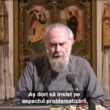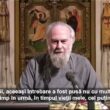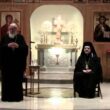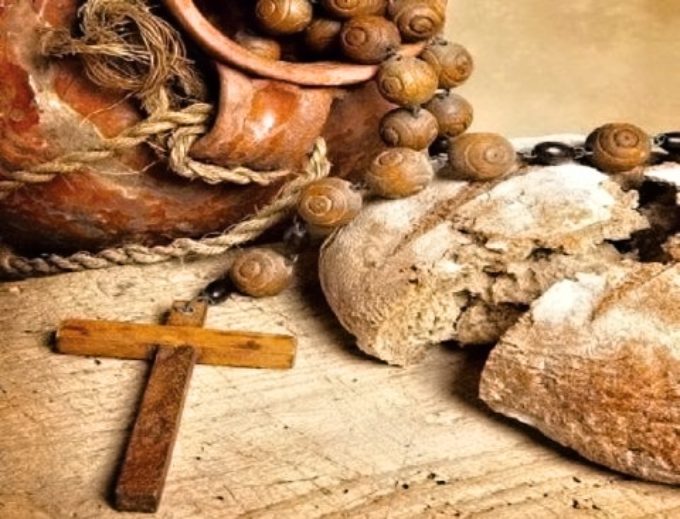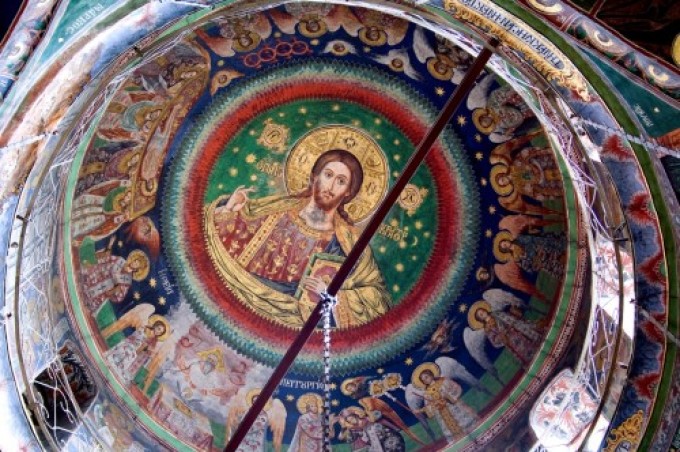byAlexandru Ghica
Christian life and ascesis are powerfully linked. Neither one of them can be understood without the other.
The believer, with the grace of the Holy Spirit tries to free himself from the yoke of sin, from the domination of passions and to make himself a true limb of the body of Christ that is the Church. In his attempt an important role is played by fasting. The word composed of the negative particle νη (no) and the verb εσθίω (to eat) . Thus derived the verb to fast and the noun fasting, which initially meant a complete abstention from food and drink and later only the partial abstention from some victuals and the consumption of others.
Fasting is a very old church ordinance. As a religious phenomenon it preceded the Christian Church.
We meet the lent in the Old Testament as well, at the Israelites but also at some other Eastern peoples, even at the ancient Greeks and Romans. The common conviction of all these peoples was that by fasting they could reconcile themselves with their gods and reach their spiritual elevation or their moral cleanse.
Our Church, among the great fasting periods of the year, considers that the Great Lent is the most ancient and most severe period of fasting. It has existed in the Church together with the Wednesday and Friday fasting since the apostolic times, as we can conclude from the doubtless historical evidence we have.
The starting point and the essence of this lent is the old fastening period kept before Easter, which was fixed in the remembrance of the sufferings of our Lord Jesus Christ and as a period of preparation of the believers for the feast of Easter and of the catechumens for baptism.
The Apostolic Constitutions link the establishment of the Great Lent of the words said by the Lord:when the bridegroom is taken away from them, they will fast in those days. Those days are according to the apostolic constitution the time before Easter. At the beginning this was not as long nor as similar in all local churches. In the primary church there was freedom in this respect. We also notice a difference in the way the Christians fasted in those times.
The exact date when it appears the Lent of 40 days as a fasting period before Easter is difficult to establish. The lent of 40 days is mentioned in the 5th Canon of the 1st Ecumenical Council that took place in Niceea, Bitinia, which makes us draw the conclusion that in the time when the Council was convened (325) the lent of 40 days represented a rule followed by the whole Church.
Other historical evidence, like that of the historian Eusebius of Cesareea, refer even more clearly at the existence of the lent of 40 days and connects its establishment as a period of fasting and spiritual preparation for Easter with the fasting of 40 days of the Lord and of the prophets Moses and Elijah.
The lent of 40 days was just as the initial fasting period before Easter had been, with differences from one place to another until its final establishment. There were differences in what regarded the period of time and the way how the Christians kept the fast.
But what we can sustain with certitude is that from the beginning the lent of 40 days was a very severe one.
The 69th Canon of the Holy Apostles threatens the clerics with the defrocking and the laymen with the excommunication if they did not keep the lent of 40 days.
According to the 50th Canon of the local church from Laodiceea (summoned around the year 360) it is recommended to fast during the lent of 40 days eating only dry food. The interpreters of the canons (Zonara and Balsamon) say that whoever eats without being sick breaks the law.
In what regards the kinds of foods and drinks the Christians had to avoid, the rule was that the fasters should refrain from meat and fish, from foods of animal origin (dairies and eggs) and from wine. The order of the fasting was that during the entire period of 40 days the Christians had to refrain from eating until the 9th hour (3pm) and avoid the foods we mentioned before.
The name of the lent taken by the long period of fasting before Easter derives from the 40 days it includes. The Apostolic Constitutions recommending the celebration of certain Christian holidays add the following: You must keep together with us the Great Lent which reminds us of the life of our Lord and of the order of His Law.
The fact that the name of the lent is connected with the number of fasting days is seen in what is told us by the Apostolic Constitutions: We keep this fasting before Easter (probably they refer at the fasting from the Holy Week) which starts on Monday and ends on Friday (before the Saturday of Lazarus) Together with them (the 40 days of the Great Lent) start the Holy Week fasting with fear and trembling.
This period of fasting was soon called the Great Lent. It was given this name not in order to distinguish it from the other fasting periods of the year, but in order to stress its special significance. The severity of this fasting and in general of the ascesis that is required and of its purpose emphasize our spiritual preparation so that we could live profoundly the Easter, the great feast of Christianity.
How must we fast nowadays during the Great Lent?
As I have already shown the Great Lent had been from its very beginning a severe one. We, the Orthodox Christians tend to keep it with a corresponding disposition of strive even in these times of wealth and consumerism.
The first week or the pure week.
Many – not only monks– keep the first three days refraining from all kinds of food and then they partake the Eucharist at the first Liturgy of the Presanctified Gifts. Others fast until evening after the Great Compline. We should continue to fast in the same way in the rest of the Great Lent as well. If we want to be consistent and in accord with the spirit of fasting, we should refrain from consuming oil during the entire week, not only on Wednesdays and Fridays.
During the Great Lent according to the Holy Canons, we can consume oil only on Saturdays and Sundays. If others consume oil in other days this should be done only for reasons of bodily illness, as it is stated in the 69th Apostolic Canon and reiterated in the 50th Canon from Laodiceea, validated by the 28th Canon of the 5th and 6th Holy Councils. All these should be done with the blessing of the spiritual confessor.
As we said during the Great Lent it is compulsory to consume oil and wine only on Saturdays and Sundays. Exceptions are when we celebrate the commemoration of the 40 martyrs and the feast of the Annunciation, when we can also eat fish.
In what regards the permission to eat fish on the Palm Sunday, some monasteries, the Triodion and saint Theodor the Studit recommend the eating of fish for two reasons. First because it marks the end of the fasting period (the Lent ends on Friday evening, before the Saturday of Lazarus). And the second reason is because it celebrates the triumphant victory of Christ against the enemy of man, the death, by the resurrection of Lazarus. Thus the Palm Sunday is considered a Major Royal Feast.
During the Holy Week the fasting is extremely severe. It is also very old and represents a part of the Great Lent. We refrain from consuming oil in all the days of this week and eat only dry food. Even on the Holy Saturday is kept a severe fasting this being the only Saturday from the year when it is kept a fast (when nothing is eaten)
Therefore we should all prepare physically and spiritually so that we can welcome as we should the Resurrection of Christ.

